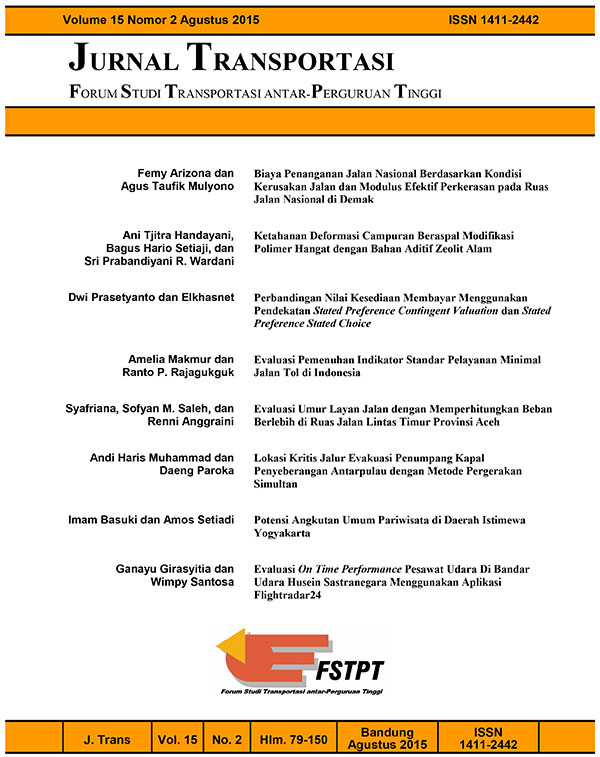LOKASI KRITIS JALUR EVAKUASI PENUMPANG KAPAL PENYEBERANGAN ANTARPULAU DENGAN METODE PERGERAKAN SIMULTAN
DOI:
https://doi.org/10.26593/jtrans.v15i2.1730.%25pAbstract
Abstract
One important factor to avoid casualties on a shipwreck is a safe evacuation route design. Number of locations that can slow the evacuation process, such as doors, stairs and corridors are essential for analysis. This paper discusses a number of critical locations that have the potential failure of evacuation, particularly in the inter-island ferry. The method used to identify the critical location or locations, where the density of passengers occurs during the evacuation process, is the Simultaneous Movement Method. The simulation results showed that the total time required to evacuate passengers was 870 seconds or 14.50 minutes. This time is much smaller than the time required by the International Maritime Organization (60 minutes). Potential passenger density or the critical path starts at the door 1 when the path traversed by all economy class passengers before entering the hall 1 and hall 2. The number of passengers that accumulates at these sites is 72 people on the 300th second. Furthermore, passenger density occurs at the meeting area of the movement passengers toward the exit deck, where the passengers come from the corridors 3 and 4. At that location the density of passengers reached 76 people in the 490th second. The potential location or the critical point of passenger evacuation path occurs at the junction between two or more evacuation lanes, especially in the transition location, such as at doors, stairs, or narrowing lane due to the large number of passengers.
Keywords: evacuation lane, critical location, evacuation time, emergency exit, ferry
Abstrak
Salah satu faktor penting untuk menghindari terjadinya korban jiwa pada suatu kecelakaan kapal adalah desain jalur evakuasi yang aman. Sejumlah lokasi yang dapat memperlambat proses evakuasi, seperti pintu-pintu, tangga, dan koridor penting untuk dianalisis. Makalah ini membahas sejumlah lokasi kritis yang berpotensi terjadinya kegagalan evakuasi, khususnya pada kapal penyeberangan antarpulau. Metode yang digunakan untuk mengidentifikasi lokasi kritis atau lokasi tempat terjadinya kepadatan penumpang selama proses evakuasi adalah Metode Pergerakan Simultan. Hasil simulasi menunjukkan bahwa total waktu evakuasi yang diperlukan penumpang adalah 870 detik atau 14,50 menit. Waktu tersebut lebih kecil daripada waktu yang disyaratkan Organisasi Maritim Internasional (60 menit). Potensi kepadatan penumpang atau jalur kritis dimulai pada pintu 1 ketika jalur tersebut dilalui oleh semua penumpang kelas ekonomi sebelum memasuki koridor 1 dan koridor 2. Jumlah penumpang yang terakumulasi pada lokasi tersebut adalah 72 orang pada detik ke-300. Selanjutnya kepadatan penumpang terjadi pada daerah pertemuan pergerakan penumpang yang menuju pintu darurat geladak, yaitu penumpang yang berasal dari koridor 3 dan koridor 4. Pada lokasi tersebut terjadi kepadatan penumpang yang mencapai 76 orang pada detik ke-490. Potensi lokasi atau titik kritis jalur evakuasi penumpang terjadi pada pertemuan antara dua atau lebih jalur evakuasi, khususnya pada lokasi transisi, seperti pada pintu, tangga, atau penyempitan jalur yang disebabkan jumlah penumpang yang besar.
Kata-kata kunci: jalur evakuasi, lokasi kritis, waktu evakuasi, pintu darurat, kapal penyeberangan


